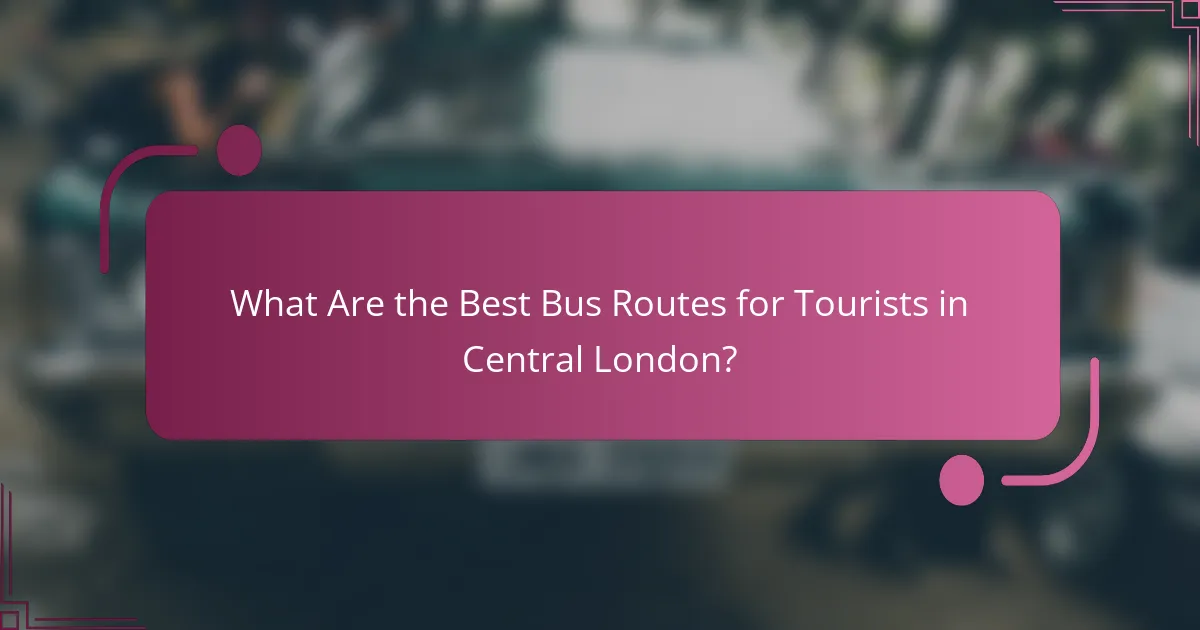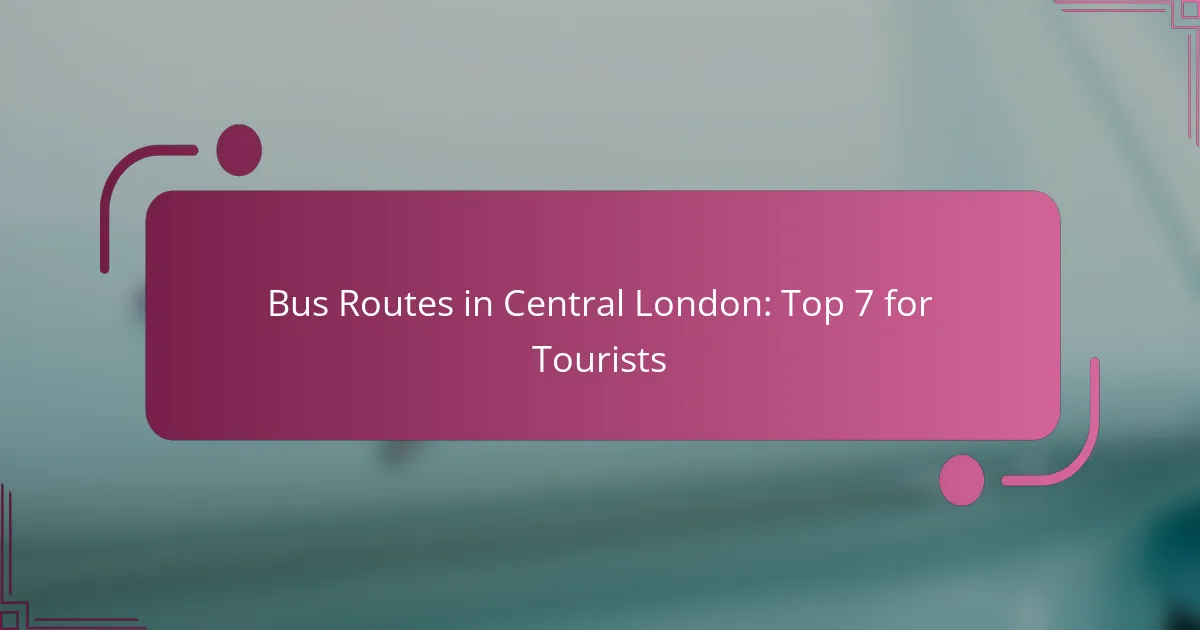Exploring Central London by bus is an excellent way for tourists to experience the city’s vibrant atmosphere while accessing major attractions. The best bus routes not only provide practical transportation but also offer scenic views that enhance the overall experience. By understanding these key routes, visitors can navigate the city efficiently and enjoy its rich history and culture.

What Are the Best Bus Routes for Tourists in Central London?
The best bus routes for tourists in Central London offer scenic views and convenient access to major attractions. These routes not only provide a practical means of transportation but also allow visitors to experience the city’s vibrant atmosphere.
Route 11: Westminster to Liverpool Street
Route 11 takes you from the iconic Westminster area, home to the Houses of Parliament and Big Ben, to the bustling Liverpool Street station. This route passes several landmarks, including St. Paul’s Cathedral and the London Eye, making it a great choice for sightseeing.
Consider hopping on this bus during off-peak hours to avoid crowds. The journey typically takes around 30-40 minutes, depending on traffic, so plan accordingly if you have specific destinations in mind.
Route 15: Trafalgar Square to Tower Hill
Route 15 connects Trafalgar Square, a hub of culture and history, with Tower Hill, near the Tower of London. This route is particularly popular for its views of the River Thames and the historic architecture along the way.
Travelers should note that this route is well-serviced, with buses running frequently throughout the day. It’s an excellent option for those looking to explore both the West End and the historic parts of the city.
Route 24: Hampstead Heath to Pimlico
Route 24 runs from the scenic Hampstead Heath to the vibrant area of Pimlico. This bus route offers a unique perspective of both green spaces and urban life, making it ideal for those who want to see a mix of London.
This route is less touristy, providing a more local experience. Expect the journey to take about 45 minutes, and be sure to check the bus schedule, as it may vary on weekends.
Route 38: Clapton to Victoria
Route 38 stretches from Clapton in East London to Victoria in the heart of the city. This bus route is known for its diverse neighborhoods and offers a glimpse into daily London life.
With a travel time of approximately 50 minutes, it’s advisable to ride during off-peak hours for a more comfortable experience. Keep an eye out for local shops and eateries along the way.
Route 73: Victoria to Stoke Newington
Route 73 connects the busy area of Victoria to the charming Stoke Newington. This route is particularly useful for tourists looking to explore both the commercial and residential sides of London.
The journey can take around 40 minutes, and buses run regularly. This route is a great way to discover local cafes and parks, especially in the Stoke Newington area.
Route 139: Waterloo to Golders Green
Route 139 travels from Waterloo, near the South Bank, to Golders Green, known for its Jewish community and vibrant markets. This route provides access to cultural sites and diverse dining options.
Expect the journey to last about 50 minutes. It’s a good idea to check the bus times, especially in the evening, as services may reduce.
Route 453: Deptford to London Bridge
Route 453 runs from Deptford to London Bridge, offering a mix of modern and historical sights. This route is particularly useful for those visiting the Borough Market or the Shard.
The travel time is typically around 30 minutes, making it a quick option for getting to central attractions. Be aware that this route can get busy during peak hours, so plan your trip accordingly.

How Do These Bus Routes Enhance the Tourist Experience?
The bus routes in Central London significantly enhance the tourist experience by providing a unique perspective of the city while ensuring easy access to popular destinations. Tourists can enjoy scenic views and convenient transport options, making it an ideal way to explore London.
Scenic views of iconic landmarks
Many bus routes in Central London pass by famous landmarks, allowing tourists to take in the sights without the need for a guided tour. For instance, routes like the 11 and 15 offer views of the Houses of Parliament, Big Ben, and St. Paul’s Cathedral.
Riding on the top deck of a double-decker bus provides an elevated vantage point, perfect for photography and appreciating the architecture. This experience can be particularly enjoyable during the day when the city is bustling with activity.
Convenient access to major attractions
Central London bus routes are designed to connect tourists with major attractions efficiently. Buses run frequently, often every 5 to 10 minutes, making it easy to hop on and off at various stops, such as the British Museum, Buckingham Palace, and Covent Garden.
Using an Oyster card or contactless payment makes travel seamless, as it allows for quick boarding and reduced fares compared to cash payments. Tourists should consider planning their routes in advance to maximize their time and ensure they visit all desired sites.

What Are the Key Features of Each Bus Route?
The key features of each bus route in Central London highlight unique attractions and experiences for tourists. Understanding these routes helps visitors navigate the city efficiently while enjoying its rich history and culture.
Route 11: Historical landmarks
Route 11 takes passengers past some of London’s most iconic historical landmarks. Starting from Fulham Broadway and ending at Liverpool Street, this route includes stops at the famous Big Ben, the Houses of Parliament, and St. Paul’s Cathedral.
Travelers can enjoy a scenic ride while learning about the city’s history. Consider hopping on this bus for a convenient way to see multiple sites without the need for extensive walking.
Route 15: Cultural hotspots
Route 15 connects key cultural hotspots, making it ideal for art and history enthusiasts. This route runs from Trafalgar Square to Tower Hill, passing by the National Gallery, the British Museum, and the vibrant Southbank area.
Using Route 15 allows tourists to explore London’s rich cultural offerings in a relaxed manner. Be sure to check the bus schedule, as it operates frequently, providing ample opportunities to hop on and off at various attractions.
Route 24: Parks and green spaces
Route 24 offers a delightful journey through some of London’s beautiful parks and green spaces. Starting at Hampstead Heath and ending at Pimlico, this route includes stops at Regent’s Park and the stunning Green Park.
For those looking to enjoy nature amidst the urban landscape, Route 24 is perfect. It’s advisable to plan your ride during daylight hours to fully appreciate the scenic views and perhaps enjoy a picnic in one of the parks along the way.

What Should Tourists Know About Bus Fares and Payment Options?
Tourists in Central London should be aware that bus fares can vary based on payment methods. Using contactless payment options or an Oyster card can significantly reduce travel costs and streamline the boarding process.
Contactless payment methods
Contactless payment methods, such as debit or credit cards, mobile wallets, and smart devices, are widely accepted on London buses. Simply tap your card or device on the card reader when you board, and the fare will be automatically deducted.
This method is convenient and often cheaper than purchasing a paper ticket. However, ensure your card is enabled for international transactions if you’re visiting from abroad.
Oyster card benefits
The Oyster card is a smart card that offers discounted fares on public transport in London, including buses. Tourists can purchase an Oyster card at various locations, including airports and train stations, or online before their trip.
Using an Oyster card can save you money compared to standard ticket prices, especially for multiple journeys. Additionally, it allows for easy top-ups and can be used across all forms of public transport in London.
Daily cap limits
Daily cap limits are the maximum amounts you will pay for travel within a single day using contactless payment methods or an Oyster card. For buses, the daily cap is set at a specific amount, ensuring that once you reach this limit, you won’t be charged for additional journeys.
This feature is particularly beneficial for tourists planning to explore the city extensively, as it helps manage travel expenses effectively. Always check the current cap limits, as they may vary based on the zones you travel through.

How Do Bus Routes Compare to Other Transportation Options?
Bus routes in Central London offer a unique way to explore the city, often providing scenic views and access to areas not served by the Tube. While buses may take longer than the Underground, they can be more economical and allow for greater flexibility in travel.
Bus vs. Tube: Pros and cons
When comparing buses to the Tube, each has distinct advantages and disadvantages. Buses are generally cheaper, with a single fare typically around £1.65, while Tube fares can vary based on zones, often starting at £2.40. However, buses can be subject to traffic delays, making them less reliable for time-sensitive travel.
The Tube is faster for longer distances, especially during peak hours when buses may be stuck in congestion. On the other hand, buses provide a more immersive experience, allowing passengers to see landmarks and neighborhoods up close. For tourists, this can enhance the overall experience of visiting London.
Consider your itinerary when choosing between the two. If you plan to visit popular attractions that are well-connected by bus routes, such as the British Museum or Covent Garden, buses may be the better option. However, for quick trips across the city, the Tube is often the most efficient choice.
